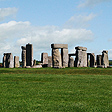BATH’S ORIGINAL ROMAN BATH
Celts, Romans, Druids and Victorians, Everybody Bathes
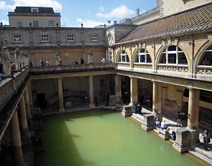 There’s no doubt about it, the Romans liked to bathe. Wherever they went to conquer and empire they managed to find the local hot springs, or cold springs, and set up a bathing house. All over Europe you can find towns with some sort of bath or bad in their names, but the most famous is the city in southwest England with the singular name, Bath. The city has become known for many things in the centuries since the Romans, from Jane Austen (see Jane Austen Center) and Regency architecture to fashion, but the principal feature of the town for tourism is the original Roman Bath.
There’s no doubt about it, the Romans liked to bathe. Wherever they went to conquer and empire they managed to find the local hot springs, or cold springs, and set up a bathing house. All over Europe you can find towns with some sort of bath or bad in their names, but the most famous is the city in southwest England with the singular name, Bath. The city has become known for many things in the centuries since the Romans, from Jane Austen (see Jane Austen Center) and Regency architecture to fashion, but the principal feature of the town for tourism is the original Roman Bath.
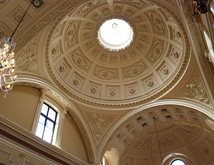 The Roman Baths and Grand Pump Room in the center of the city are one of the most visited sights in in south England, where the history of Roman times can be explored, but actual bathing in the waters is not part of the program, but the hot spring water which originally rose through limestone aquifers, rechanneled and aided by a pump system can be sampled in the Pump Room, which is now a restaurant.
The Roman Baths and Grand Pump Room in the center of the city are one of the most visited sights in in south England, where the history of Roman times can be explored, but actual bathing in the waters is not part of the program, but the hot spring water which originally rose through limestone aquifers, rechanneled and aided by a pump system can be sampled in the Pump Room, which is now a restaurant.
The baths themselves are below the street level of modern Bath in a columned pool like area open to the sky and surrounded by statuary. Costumed Roman soldiers and characters take positions around to lend an air of period and for photo opportunities. There are four main sections the bathe site: the Sacred Spring, the Roman Temple, the Roman Bath House, and the Museum. The museum on the lower underground level houses original artifacts, many of them thrown into the baths as offerings, from the Roman times and other eras, including one of the largest collections of Roman coins, while life-size holographic-like movies depict the life of the Romans. The foundations of the baths can be explored while continuing excavations uncover more of earlier constructions.
History
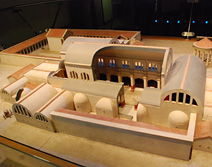 In legend, the credit for the founding of the bath was given to the Britannic King Bladud about 800 BC by Geoffrey of Monmouth, who also gave accounts of mythical origins of Merlin (see and King Arthur. An embellishment of the story had King Bladud and a herd of pigs cured of leprosy in the muds of the waters. A statue of the king now presides over a corner of the bath. The first known shrine at the site was built by the Celts to their goddess Sulis. The Romans arrived about 60 AD and changed to Sulis to their Minerva, constructing a Roman Temple, with the bathing buildings constructed around the time of the Emperor Claudius, expanded over the next 300 years, until the Romans departed and the much of the original roman constructions and shrines were destroyed by the Anglo-Saxons.
In legend, the credit for the founding of the bath was given to the Britannic King Bladud about 800 BC by Geoffrey of Monmouth, who also gave accounts of mythical origins of Merlin (see and King Arthur. An embellishment of the story had King Bladud and a herd of pigs cured of leprosy in the muds of the waters. A statue of the king now presides over a corner of the bath. The first known shrine at the site was built by the Celts to their goddess Sulis. The Romans arrived about 60 AD and changed to Sulis to their Minerva, constructing a Roman Temple, with the bathing buildings constructed around the time of the Emperor Claudius, expanded over the next 300 years, until the Romans departed and the much of the original roman constructions and shrines were destroyed by the Anglo-Saxons.
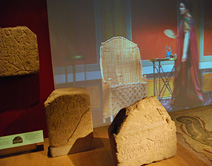 The present buildings of the baths where built in the 18th Century designed by local architects John Wood the Elder and his son, John Wood the Younger. It was Wood, who had an interest in Druidism and Freemasonry and had surveyed the nearby site of Stonehenge (see Visiting Stonehenge) who added to the legend of King Bladud’s connection to the bath. Further expansions followed the Wood’s inspirations and the neo-classical Grand Pump Room designed by Thomas Baldwin in 1789, remains the symbol of the age for visitors who came for social occasions and to “take the waters”. The Roman Bath Museum and the Queen's Bath were added in the Victorian Age designed by Charles Edward Davis in 1889.
The present buildings of the baths where built in the 18th Century designed by local architects John Wood the Elder and his son, John Wood the Younger. It was Wood, who had an interest in Druidism and Freemasonry and had surveyed the nearby site of Stonehenge (see Visiting Stonehenge) who added to the legend of King Bladud’s connection to the bath. Further expansions followed the Wood’s inspirations and the neo-classical Grand Pump Room designed by Thomas Baldwin in 1789, remains the symbol of the age for visitors who came for social occasions and to “take the waters”. The Roman Bath Museum and the Queen's Bath were added in the Victorian Age designed by Charles Edward Davis in 1889.
VISITING ROMAN BATHS OF BATH
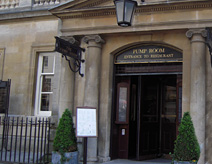 The Roman Baths are open daily throughout the year (except December 24 and 25), on varying hours, generally 9am to 5pm with exit by 6pm, with late evenings in July and August, last entry at 9pm with exit at 10pm. A variety of tickets are available, including a Saver Ticket which also include the Bath Fashion Museum and Victoria Art Gallery, as well as a Family Saver Ticket and Season ticket.
The Roman Baths are open daily throughout the year (except December 24 and 25), on varying hours, generally 9am to 5pm with exit by 6pm, with late evenings in July and August, last entry at 9pm with exit at 10pm. A variety of tickets are available, including a Saver Ticket which also include the Bath Fashion Museum and Victoria Art Gallery, as well as a Family Saver Ticket and Season ticket.
A standard adult ticket is £14, Students and Seniors are £12.25, and children to 16 are £9. (Prices are a bit higher in July and August). Special Packages with dining in the restaurant are available like a “Combined Ticket and Lunch”, “Twilight Tours and Dinner” or “Baths Ancient and Modern”. Visitors to Bath who book hotel rooms through the tourist office can get 2 for 1 combined Entry to the Roman Baths, the Fashion Museum (see Bath Fashion Museum) and Victoria Art Gallery. © Bargain Travel Europe
Find best hotel and travel deals in Bath on TripAdvisor
Web Info
Roman Baths
These articles are copyrighted and the sole property of Bargain Travel Europe and WLPV, LLC. and may not be copied or reprinted without permission.
SEE ALSO:
GLOUCESTER CATHEDRAL - EDWARD II & HARRY POTTER


